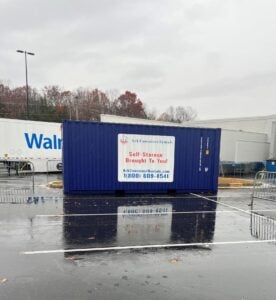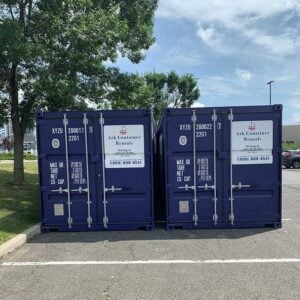Back in 1956, a man named Malcolm McLean looked at how cargo was being shipped and realized it was a complete mess. At that time, freight was loaded onto ships piece by piece—barrels, boxes, bags, and crates were all handled individually. The process was slow, expensive, and exposed to theft and damage.
McLean, who had a background in trucking, figured there had to be a better way. He introduced the concept of using standardized steel boxes that could be loaded once and moved across trucks, ships, and trains without unpacking the contents. That idea led to the invention of the modern shipping container, and it didn’t take long for the industry to catch on.
Today, more than 90 percent of the world’s cargo is transported using shipping containers. McLean’s solution didn’t just make shipping easier. It triggered a complete shift in how goods move around the globe.
A New Era: The Rise of Containerization
Containerization isn’t just a fancy term—it marked one of the most important changes in modern trade. Introducing a consistent, reliable system for moving goods allowed businesses to save time, reduce losses, and scale their operations across borders.
Before containers, loading and unloading a cargo ship could take up to a week. With containers, that same ship could be turned around in less than a day. Port cities became more efficient, labor costs dropped, and theft was significantly reduced since containers could be sealed and locked at the point of origin.
It also gave rise to what’s known as intermodal transportation. That means goods can move across different forms of transport, in trucks, trains, or ships, without being repacked. The container stays shut the whole way. This system is now the backbone of international logistics.
Beyond the Dock: Storage and Business Applications
Once businesses saw how containers transformed shipping, it didn’t take long for them to realize these boxes had other uses. One of the biggest offshoots of the container industry has been portable storage.
Construction companies began using containers as secure on-site storage for tools, equipment, and materials. Schools and municipalities leased containers to hold overflow supplies. Retailers used them to manage seasonal stock. The sturdy steel design made them weatherproof, tamper-resistant, and mobile. Unlike traditional buildings, containers didn’t require permits or permanent foundations. That made them fast, affordable, and flexible.
Containers also created opportunities for entrepreneurs. Some modified them into mobile offices. Others converted them into workshops, kiosks, or compact retail spaces. The versatility of the container made it one of the most valuable tools in modern business.
Real-World Use Across Industries
Shipping containers are now part of daily operations for companies, large and small. Here’s how different industries put them to work:
- Construction: Builders use containers to store materials at job sites. Instead of hauling tools back and forth each day, they keep everything locked up and ready to go.
- Retail: From national chains to local shops, retailers lease containers for overflow storage during holiday seasons or sales events.
- Hospitality: Hotels undergoing renovations use them to store furniture and supplies off-site, keeping the project moving without crowding the property.
- Logistics: Freight companies use container chassis to transport goods both locally and internationally. These are the same types of containers that travel across oceans and down highways.
- Government: Emergency services, school districts, and public works departments lease containers for temporary storage during busy seasons or project rollouts.
The container’s durability, portability, and low cost make it hard to beat when space and security are needed fast.
Customization: Not Just a Box Anymore
One of the reasons shipping containers are so popular is their ability to be customized. Because they’re made of heavy-duty steel and have a strong structural frame, they can be altered in many ways without losing stability.
Businesses can add roll-up doors, lighting, shelving, and even HVAC systems. Full panels can be removed to add windows or entrances. Containers can be stacked to create larger structures or cut down to fit into smaller spaces.
This has led to a growing trend: using containers as building blocks for homes, restaurants, and pop-up shops. In cities with limited space, containers are a smart way to build quickly and affordably. They also bring a clean, industrial look that appeals to modern design.
Types of Containers and Their Uses
Not all storage containers are the same. Depending on your needs, there are different sizes and styles available:
- Standard Containers: These come in 20-foot and 40-foot lengths and are 8 feet wide by 8 feet 6 inches tall. They’re ideal for most storage and shipping needs.
- High Cube Containers: These are the same length and width as standard containers but are one foot taller, providing extra space for larger items or taller equipment.
- Bicons (also called Duocons): These are 20-foot containers that can be cut in half to create two 10-foot units. They’re a great fit for tight spaces, especially in urban areas or residential backyards.
This variety makes it easy to find a container that fits your space and purpose.
A Legacy That Keeps Growing
Malcolm McLean didn’t set out to change the world. He just wanted to solve a problem. But his invention has done more than speed up shipping—it has influenced economies, improved access to goods, and launched entire industries.
The shipping container has gone far beyond its original purpose. It’s now a tool for innovation, adaptability, and efficiency. Whether it’s holding freight, storing supplies, or serving as a mobile office, it continues to prove its worth.
At ARK Container Rentals, we believe in the power of practical solutions. Shipping containers offer the flexibility businesses need to grow and solve problems on their own terms. That’s a legacy worth building on.








